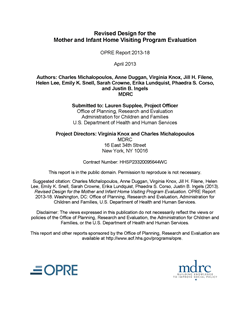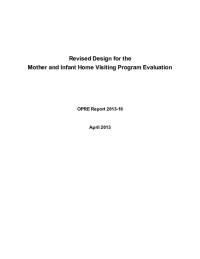Revised Design for the Mother and Infant Home Visiting Program Evaluation

Home visiting programs in the United States seek to improve maternal and child health, child development, and family economic self-sufficiency by supporting and educating families with young children. Today, home visiting is seen as an important strategy for high-risk families who may be difficult to engage in other services. The Patient Protection and Affordable Care Act (ACA) of 2010 included $1.5 billion over five years for states to operate the Maternal, Infant, and Early Childhood Home Visiting (MIECHV) program. It also required a national evaluation of the programs. This document describes the design of that evaluation — the Mother and Infant Home Visiting Program Evaluation (MIHOPE). MIHOPE was launched in 2011 by the Administration for Children and Families and the Health Resources and Services Administration within the U.S. Department of Health and Human Services. The evaluation is being conducted by MDRC in partnership with Mathematica Policy Research, James Bell Associates, Johns Hopkins University, the University of Georgia, and Columbia University.
MIHOPE will include the following components:
- An analysis of state needs assessments will describe the communities that states chose to target with MIECHV program services
- An implementation study will collect information on the services provided by local programs as well as the factors that helped shape those programs.
- An impact analysis will estimate the effects of home visiting programs on family outcomes, both overall and for key subgroups of families.
- An economic analysis will assess program costs and savings.
The study will include approximately 5,100 families with a pregnant woman or a child under 6 months old. Families who enroll in the study will be randomly assigned to a home visiting group or to a comparison group that can use other services available in their community. Families will be spread across about 85 local programs in about 12 states. Sites must be operating one of four national models of home visiting: Early Head Start-Home Visiting Option, Healthy Families America, Nurse-Family Partnership, or Parents as Teachers. These four models were chosen because they are being implemented using MIECHV program funds in at least 10 states.
Data for the implementation and impact studies will be collected from a variety of sources, including interviews with parents; observations of the home environment; observed interactions of parents and children; direct assessments of children’s development; observations of home visitors in their work with families during home visits; logs, observations, and interviews with home visitors, supervisors, and program administrators; program model documentation from program developers, grantees, and local sites; and administrative data on child abuse, health care use, maternal health, birth outcomes, and employment and earnings.
The study will produce a report to Congress in 2015 that includes information on families and sites included in the evaluation as well as information on how states made decisions about how to spend home visiting funds. Later reports will provide more information on program implementation, the effects of home visiting programs for families, and the features of programs that are associated with larger effects.






